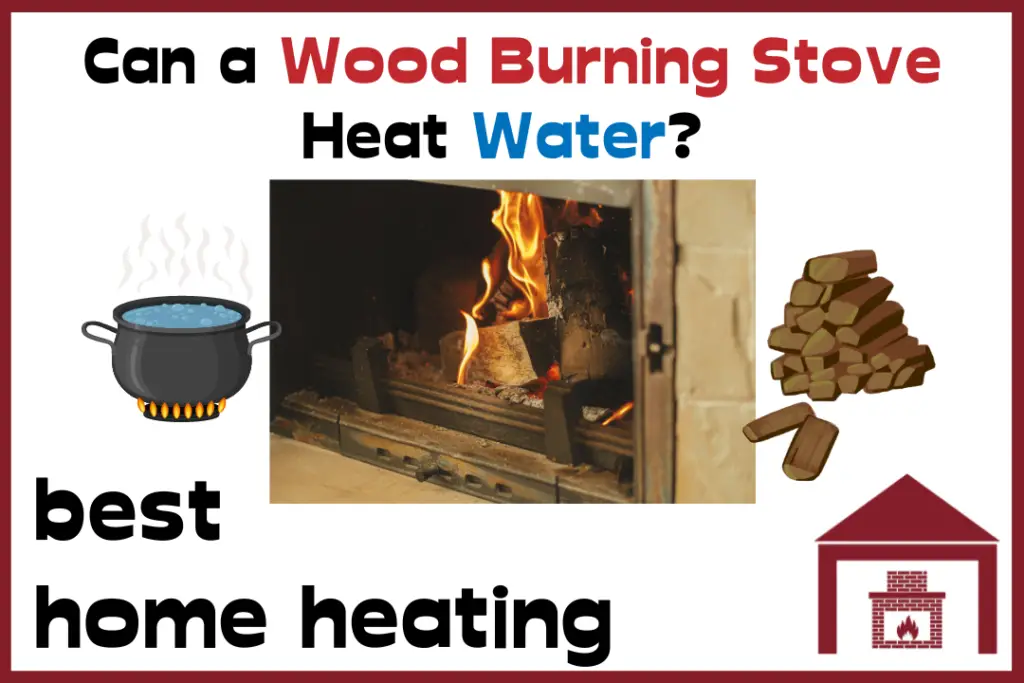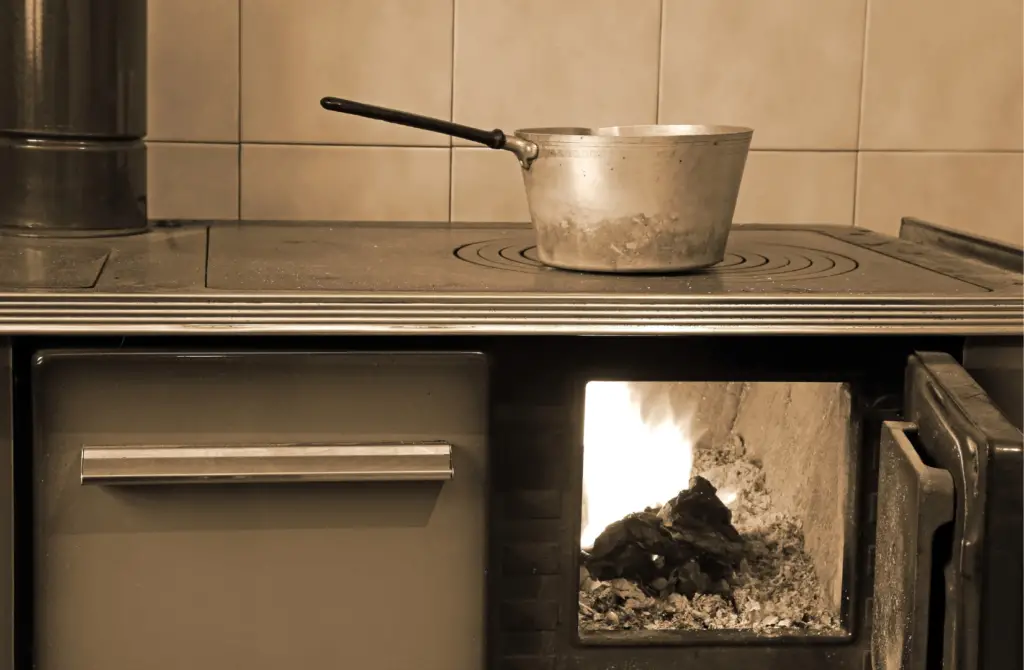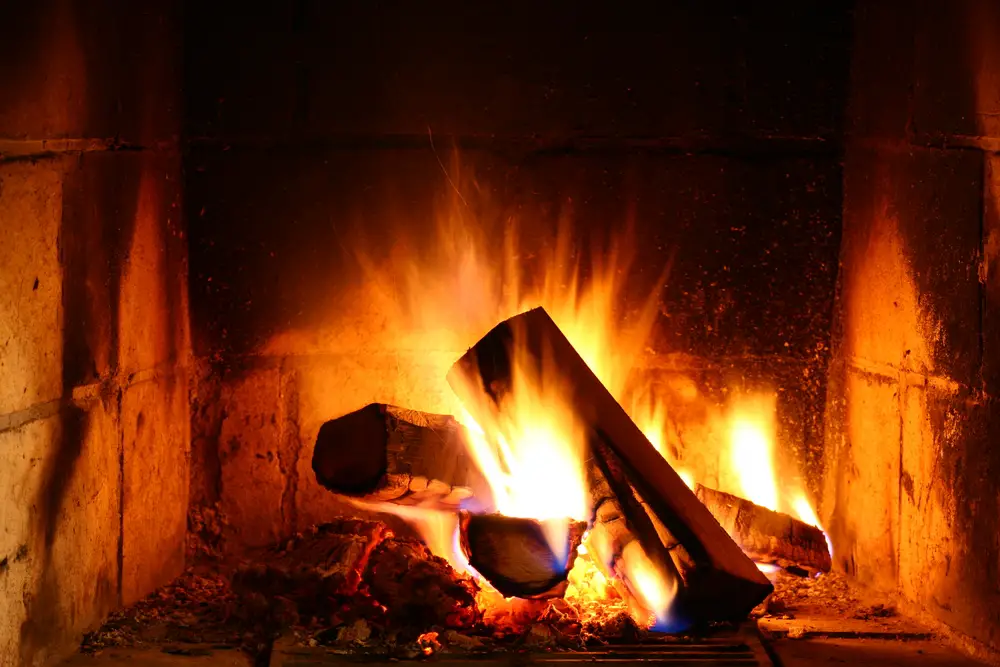Wood burning stoves are increasingly popular in UK and Ireland homes due to their enhanced heating efficiency, yet prospective users often wonder if these systems can also effectively heat water.
Wood Burning Stoves can heat water. You can either heat water by placing a pan with water on top of the stove or integrating it with a hot water cylinder/back boiler if it does not already. This eventually helps to provide hot water for domestic purposes and helps save electricity bills for heating.
Keep reading to understand how a wood burning stove work and how it heats water using the back boiler.

Can a Wood Burning Stove Heat Water?
Wood Burning Stoves can heat water. They typically heat water in the ways listed below:
- Direct Placement of a pan with water on the stove
- Integration with Central Heating systems
- Integration with Hot Water Cylinders
Direct Placement of a Pan with Water on the Stove
Wood burning stoves were originally designed to help to keep the home warm and cozy, but you can also harness the heat coming from the top of the stove. This is even more efficient if your wood burning stove is made from conductive materials like Cast-Iron.
Most wood burning stoves have flat tops where you can place your pots, pans, or kettles to harness the heat generated from that area. This way you can save money on gas and electricity by using your wood burner as a cooking stove. On average, it takes around 25 minutes for the water to boil.
Even if you do not intend to boil water with the heat generated from the top of the stove, it may be a good idea to keep a pot, pan, or kettle with water in it. This is because wood burning stoves tend to dry out the air in an area as they heat up that space.
This phenomenon is much more common in rural or older houses that lack proper insulation or weatherizing measures.
Eventually, the pan or kettle with water, placed on the wood burning stove’s flat top will generate steam that will ultimately help to humidify the air in the room.
Integration with Central Heating Systems
You can also integrate wood burning stoves with central heating systems like water underfloor heating systems.
Here you will need to incorporate a back boiler or a hot water tank to the stove that would supply hot water to the underfloor heating pipes.
This should only be carried out by a professional, as the installation is not as straightforward as it may sound.
Integration with Hot Water Cylinders
Traditional wood burners usually had back boilers which was a tank/cylinder connected to the back of the stove. The heat is radiated from the back of the stove into the tank.
Nowadays, modern-day wood burners also have back boilers, but these back boilers have been modified to have a gravity feed system that helps keep the water moving.
Basically, water is fed into the boiler from the bottom and hot water is gotten from the top.
This back boiler system heats water on demand, meaning you get an unlimited supply of hot water. The downside to the system is that it has a history of tank explosions due to pressure build-up and incorrect installation. Also, there could be a slight delay in the hot water reaching the tap.
This system also has an efficiency of about 70%. This is because energy is lost to the chimney as the heat is generated.
Another method of getting hot water from wood burning stoves is through immersion heaters. This is made possible through an indirect connection between the wood burning stove and a water tank.
Here, wood burning stove directly heats the coil in the water tank, which eventually transfers the heat to the water in the tank. For this system, it means, you will always have hot water on demand. But it is slightly more efficient and eliminates the risk associated with back boilers.
How Do Wood Burning Stoves Work?
Wood burning stoves generate heat by burning wood as fuel. The heat generated is then transferred to a hot water tank or a living space, using conduction and convection.
The stove creates a controlled space for the wood to be burned so that it can heat the area around it. As soon as the fuel (wood) is placed into the stove and is ignited, combustion begins. The air vents on the stove control the amount of airflow into the firebox which determines how well the wood burns (efficiency).
The gases produced during combustion remain inside the firebox much longer than in open fireplaces, this then allows the fire to burn hotter.
As the wood burns, the metal enclosure for the stove radiates heat out of the stove into the surrounding area.
For stoves with boilers, as the heat is generated, the heat is transferred to a tank containing water, which can later be used for domestic purposes.
It can also be connected to central heating systems like underfloor heating systems. The water stored in the tank is passed into the pipes for the underfloor heating system, which eventually transfers the heat to your home. Also, not all wood burning stoves have chimneys, it all depends on their design.
Are there Specialized Boiler Stoves?
Yes, there are specialized boiler stoves. These types of stoves help heat water and provide heat for living spaces. They usually have a built-in boiler or an external boiler fitted on the back of the stove’s body.
These stoves are a clean and reliable heat source for your home and water. This eventually helps reduce your hot water bill as well as your carbon footprint.

Can any Model of Wood Burning Stove be Used to Heat Water?
No, you cannot. You can only make use of stoves with back boilers or hot water tanks to boil water. There are basically two types of wood burning stoves. The Boiler stove and non-boiler stoves.
- Boiler Stoves
Boiler Stoves usually have a tank or a storage unit that holds water and heats it by harnessing the heat coming from the stove. These types of stoves can conveniently heat water and living spaces without any loss in efficiency.
- Non-Boiler Stoves
Non Boiler Stoves are not equipped to heat water. They are only used to heat the room where they are situated. As a result, they are mostly cheaper than boiler stoves of the same power rating.
For non-boiler stoves with flat tops, some people may decide to place pots, pans, and kettles on them, to boil water. This is not ideal, as it may take a while before the water actually boils.
Can Wood Burning Stoves Heat Radiators?
Just like the way wood burning stoves heat water, they can also heat radiators. This is only possible if the wood burning stove has a back boiler attached to it.
Therefore when the stove is running, it not only heats the room but also heats the boiler. The boiler which is already connected to the radiator can now draw heat from the boiler through a heat transfer method known as convection.

Conclusion
Wood Burning stoves are another efficient means of heating your home. They can also be used to boil water, as long as they come with a back boiler/hot water cylinder or can be fitted with one. This eventually helps to reduce the total cost spent on heating annually.
Unlike open fireplaces, wood burning stoves are more efficient and can burn even hotter. This is because the gases generated during combustion do not escape easily.
Wood Burning stoves can also be integrated with central heating systems like underfloor heating systems and radiators to heat an entire home. This also depends on the capacity of the stove.
References
- Boilerguide.co.uk: How to connect wood burner to central heating
- Villageandcottage.com: Can a log burner boil water
- Agreealternatives.co.uk: Boiler Stoves
- Charwood.com: The Beginner’s guide to boiler stoves
- Mullendomestic.com: Why choose a boiler stove instead of a non-boiler stove
- Blog.gr8fires.co.uk: Can you heat your radiators with a burning stove
